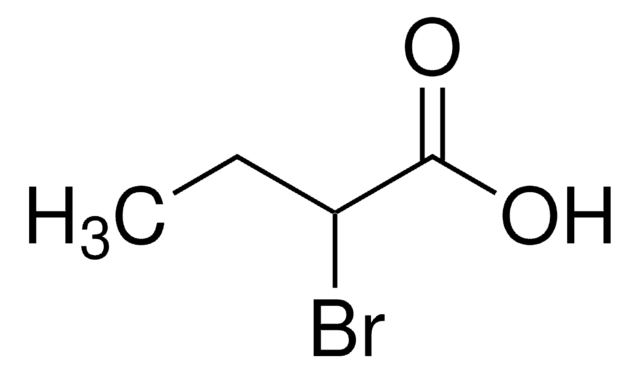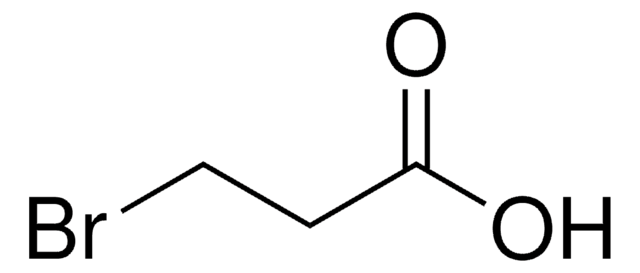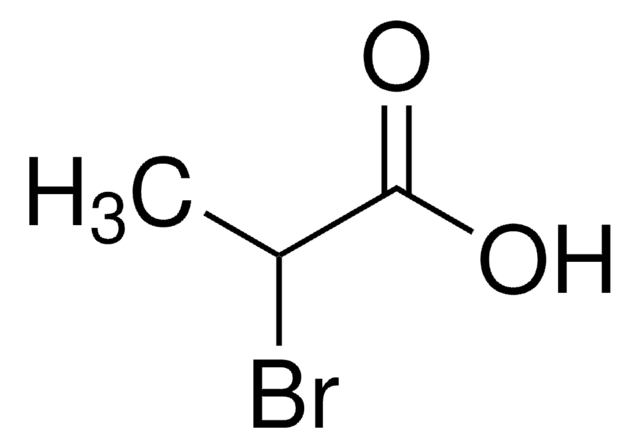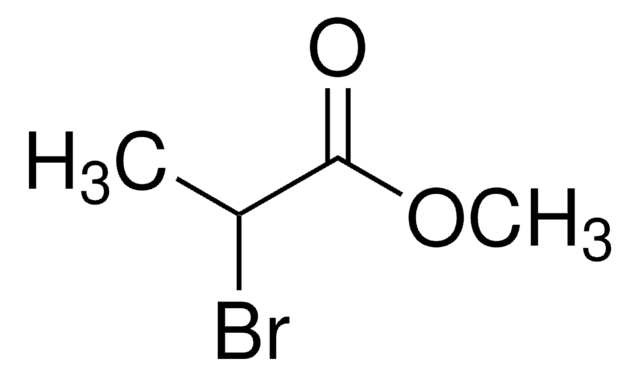139947
2,3-Dibromopropionic acid
98%
Autenticatiper visualizzare i prezzi riservati alla tua organizzazione & contrattuali
About This Item
Formula condensata:
CH2BrCHBrCOOH
Numero CAS:
Peso molecolare:
231.87
Beilstein:
1721428
Numero CE:
Numero MDL:
Codice UNSPSC:
12352100
ID PubChem:
NACRES:
NA.22
Prodotti consigliati
Livello qualitativo
Saggio
98%
Stato
solid
P. ebollizione
160 °C/20 mmHg (lit.)
Punto di fusione
64-66 °C (lit.)
Gruppo funzionale
bromo
carboxylic acid
Stringa SMILE
OC(=O)C(Br)CBr
InChI
1S/C3H4Br2O2/c4-1-2(5)3(6)7/h2H,1H2,(H,6,7)
ZMYAKSMZTVWUJB-UHFFFAOYSA-N
Cerchi prodotti simili? Visita Guida al confronto tra prodotti
Categorie correlate
Applicazioni
2,3-Dibromopropionic acid was used in chemical shift imaging during analysis of multiple samples by multiplex sample NMR methodology. It was used as surrogate standard during extraction and determination of haloacetic acid in drinking water.
Avvertenze
Danger
Indicazioni di pericolo
Classi di pericolo
Skin Corr. 1B
Codice della classe di stoccaggio
8A - Combustible corrosive hazardous materials
Classe di pericolosità dell'acqua (WGK)
WGK 3
Punto d’infiammabilità (°F)
Not applicable
Punto d’infiammabilità (°C)
Not applicable
Dispositivi di protezione individuale
Eyeshields, Faceshields, Gloves, type P3 (EN 143) respirator cartridges
Scegli una delle versioni più recenti:
Possiedi già questo prodotto?
I documenti relativi ai prodotti acquistati recentemente sono disponibili nell’Archivio dei documenti.
Carles Planas et al.
Analytical and bioanalytical chemistry, 411(17), 3905-3917 (2019-06-04)
A fast, simple, selective, and sensitive method for the analysis of 11 haloacetic acids (HAAs) in chlorine-treated water has been developed. The method is based on liquid chromatography-electrospray ionization-triple quadrupole tandem mass spectrometry (LC/ESI-QqQ-MS/MS) with direct injection of the aqueous
Occurrence and Determination of Haloacetic Acids in Metro Manila Drinking Water.
Rodriguez IB and Espino MPB.
Science Diliman, 21(2), 35-41 (2010)
T Hou et al.
Analytical chemistry, 73(11), 2541-2546 (2001-06-14)
Two improved approaches for the rapid analysis of multiple samples using multiplex sample NMR are described. In the first approach, frequency-selective 90 degrees radio frequency pulses and large pulsed field gradients are applied to excite and detect multiple samples in
Tarek Manasfi et al.
International journal of hygiene and environmental health, 220(3), 583-590 (2017-02-16)
An undesirable consequence of disinfection is the formation of chemical contaminants known as disinfection byproducts (DBPs). Chronic exposure to DBPs has been linked to adverse health effects. The occurrence of DBPs in chlorinated pools filled with seawater (such as thalassotherapy
Tarek Manasfi et al.
International journal of hygiene and environmental health, 222(1), 1-8 (2018-07-23)
Chlorination of seawater is one of the most effective technologies for industrial biofouling control. However, chlorination leads to the formation of halogenated chlorination byproducts (CBPs) associated with potential risks to environmental and human health. The present study investigated the occurrence
Il team dei nostri ricercatori vanta grande esperienza in tutte le aree della ricerca quali Life Science, scienza dei materiali, sintesi chimica, cromatografia, discipline analitiche, ecc..
Contatta l'Assistenza Tecnica.









